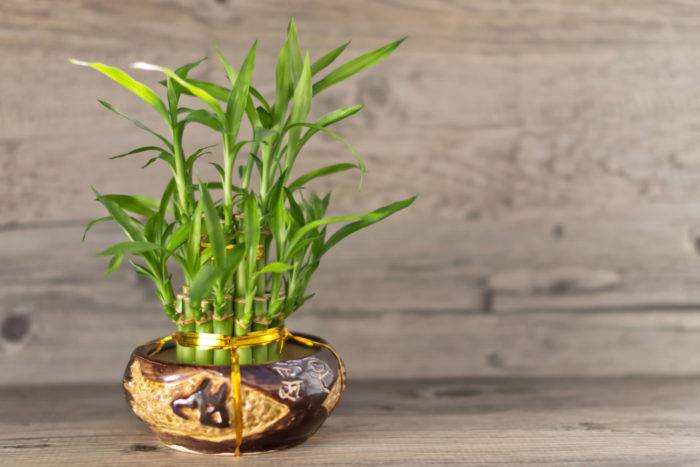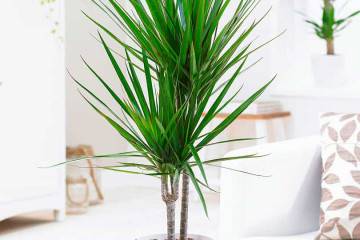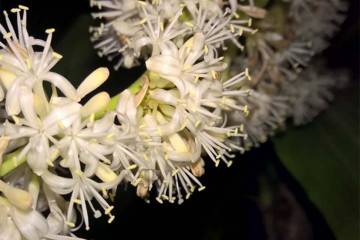Dracaena Sander flower - planting and care
Content:
Dracaena Sandera is a home-grown tropical plant. Outwardly, it resembles bamboo, but has nothing more to do with it.
What does Dracaena Sander look like, which family does it belong to
It is a woody plant from Asparagus. Previously, the genus was included in the Agavov family.
Grows vertically, branches from the beginning of the stem. The foliage is silvery, the plates reach 25 cm, they are curved. The edges of the leaves are wavy. There are stripes along them, because of which it seems that the greenery is variegated. The green flexible stem is similar to the bamboo, only thicker. Therefore, Dracaena Sander is also called the bamboo of happiness.
Common varieties
Sandera is the most common type of Dracaena. Popular varieties:
- Golden Lotus - greenish-yellow striped leaf plates;
- Whiskers - there is a light line in the center of the leaves;
- Boringuensis - a dark emerald strip runs against a green background of foliage;
- Moon Shine - whitish and silvery lines on herbaceous plates;
- Dracaena Lucky Gold bamboo - light green leaves are framed with a yellowish border, there may be golden strokes in the center;
- White - snow-white leaf plates with a wide pale emerald line in the middle;
- Celes - green foliage.
Each variety is adapted for captive cultivation.
History of appearance
Dracaena bamboo is native to Africa and southern Asia. Some scientists suggest that the Canary Islands are the homeland. Others believe that the plant was brought from the Congo, Cameroon forests.
Features of caring for Dracaena Sander at home
Temperature
The optimum temperature is + 18 ... + 21 ° С. Allowable - + 16 ... + 30 ° С. The minimum short-term is +14 ° С. At temperatures above +35 ° C, the bush will fall into a state of stagnation.
Lighting
From March to September, direct sunlight is required in the morning and evening. At noon (from 11 to 17), the plant needs to be shaded. In cloudy weather, this is not necessary.
Watering
Dracaena Sanderiana or lucky bamboo is a moisture-loving plant. Therefore, in spring and summer, it must be watered abundantly when the top layer of the earth dries up.
Humidity and spraying
High humidity is desirable for a tropical plant. However, the flower can also grow indoors with dry air. It is not recommended to spray it, it is better to wipe it with a damp cloth.
Priming
When grown in liquid, it should be changed every 2 weeks. The water should be soft, free of chlorine and salts. It is recommended to use a rainfall. The roots of the plant must be constantly covered with water, its level in the container is at least 5-6 cm.
The soil should be loose, with an acidity reading of 6.5. A mixture of earth and sand (1 to 2) is suitable.
Top dressing
Regardless of where the flower grows, it needs to be fed with fertilizers for dracaena or complex mineral mixtures.
Top dressing is applied once every 3-4 weeks from spring to mid-autumn. If the plant is in water, reduce the dose indicated on the package slightly.
Features of winter care (how to care for Dracena Sanderian), rest period
From October to February, in clear weather, the plant must be placed in direct sunlight. For this period, reduce the number of waterings. The plant rests from November to the end of February. During this period, it does not need to be fertilized.
When and how it blooms
Pruning
The growth and shape of Dracaena Sandera must be monitored. Otherwise, after planting one stem, many shoots will soon appear. Because of this, the plant will look shapeless and unkempt. Therefore, young shoots must be cut off.
How Dracaena Sander reproduces
The plant is propagated in several ways.
Germinating seeds
This method of reproduction is impractical, because Sandera rarely gives seeds.
Rooting cuttings
Cuttings can be rooted in water or soil. With the 1st option, activated carbon must be added to the liquid to avoid decay.
When rooting in the ground, the cuttings must be thoroughly moistened beforehand. A soil mixture of peat and sand (2 to 1) is suitable for planting.
Air layering
Step-by-step actions:
- Make a T-shaped incision under the leaf scar. It should be deep, reaching the middle of the stem;
- Place the wire inside so that the incision does not start to overgrow;
- After growing the roots, separate the stalk from the mother bush;
- Place in a pot of peat and sand, cover with glass.
You can remove the shelter in 3-4 days.
Other options
Dracaena can be propagated using dormant shoots. They need to be placed in water, and after the roots appear, transplanted into a pot. If you plan to grow the specimen in liquid, leave the trim in the container.
Transfer
A month after the purchase, the bush dive into the pot 1 cm larger than the previous one. Step by step process:
- Lay out drainage.
- Pour earth.
- Remove the plant by examining the roots. No sponges should be attached to them.
- Place the bush in a new pot, cover with earth, without tamping too much.
Subsequently, a transplant must be performed every 2 years.
Possible growing problems and diseases
You need to know how to care for Dracaena Sandera at home. Otherwise, problems may arise that are eliminated by adjusting the conditions of detention:
- drops buds and leaves - decay of roots due to excessive watering (the bush needs to be transplanted or root cuttings);
- leaves turn pale - lack of lighting, too high room temperature;
- the tips of the leaves dry - low humidity;
- the lower leaves fall off - you should not worry, this is a natural aging process.
Pests
The same pests can start as on other types of dracaena:
- spider mite;
- thrips;
- aphid;
- mealybug.
In the fight, you can use folk remedies, with severe damage - chemical preparations.
Other problems
The plant can be affected by fungal diseases. They are treated with copper fungicides.
Signs and superstitions
A plant in a home or office is believed to be conducive to good luck. Dracaena bamboo brings happiness with a certain number of stems:
- 3 - positive energy and joy;
- 5 - financial well-being;
- 7 - good health;
- 21 - prosperity and well-being.
In general, the number of stems can be any, with the exception of 4. This figure will attract trouble and grief.
The ribbon can be golden. Also, an image of a frog, dragon, panda, elephant, dog is applied to the pot.
Summing up, we can say that bamboo dracaena requires minimal care at home. At the same time, she will bring a zest to any room with her extraordinary appearance, fill it with positive energy.



















